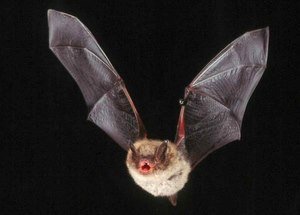NOTE: This program was originally scheduled for March 16, but will be held on March 30.
US Fish and Wildlife Service, Northeast Region
In February 2006 some 40 miles west of Albany, New York, a caver photographed hibernating bats with an unusual white substance on their muzzles. He noticed several dead bats. 
Sick, dying and dead bats have been found in unprecedented numbers in and around caves and mines from Vermont to Virginia. In some hibernacula, 90 to 100 percent of the bats are dying.
While the bats are in the hibernacula, the affected bats often have white fungus on their muzzles and other parts of their bodies. They may have low body fat. These bats often move to cold parts of the hibernacula, fly during the day and during cold winter weather when insects they feed upon are not available, and exhibit other uncharacteristic behavior.
Despite the continuing search to find the source of this condition by numerous laboratories and state and federal biologists, the cause of the bat deaths remains unknown. Recent identification of a cold-loving fungus could be a step toward and answer.
Scott Darling, a Vermont Fish and Wildlife biologist, has been directly involved in seeking some understanding of the causes of white-nose syndrome and with developing certain countermeasures. Scott will speak on “Bats in the Balance” on Tuesday, March 30, at 7:00 p.m. at the Rutland Free Library. Plan to attend!